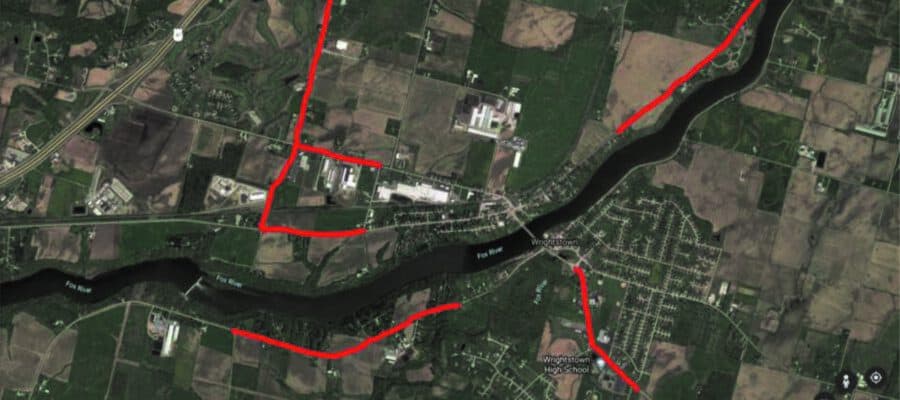Village of Wrightstown illustration
The red line on this map shows the restrictions on riding ATV/UTV vehicles in the village of Wrightstown. A summary of streets that could not be traveled is listed below the map.
By Brian Roebke
Editor
It was a different story last week than the previous meeting of the Wrightstown Village Board regarding a possible ATV/UTV ordinance that would allow the vehicles to be driven on village streets.
At the previous meeting, there was largely opposition among trustees to the idea, but at this meeting, the advocates from the community were in attendance, and several village board members expressed their agreement with them.
Police Chief Greg Deike, at the request of the board, crafted a possible ordinance that makes it tough for the vehicles to get around.
The parade of speakers started with Eric Welhouse, a trail boss who said Wrightstown cuts off a route from just north of Milwaukee to the Keweenaw Peninsula in Upper Michigan. Communities to the north and south of the village are relaxing their ordinances.
“We fought really hard to see that the snowmobile trail would go through basically across the bridge,” he said.
Welhouse acknowledged there are pros and cons to allowing the vehicles but he didn’t think there would be a single file of four-wheelers, but there would be big groups.
“Once you get north of here about 30 miles, that’s when you’re actually going to be hitting an actual trail,” he said.
One inconvenience riders would have is needing to get a registration license/sticker from every municipality they ride through, including Wrightstown, after they obtain an annual state permit.
Lee Martin said he was in favor, as did Greg Gutzman and Justin Kersten, who thought it would be awesome for the community to allow the vehicles, and it would have a bigger effect for people inside the community than outside the community.
“Just like anything else that’s illegal, people are still going to do it but if you put the right laws in place, maybe they’ll get smarter and follow those laws,” Kersten said. “I think it would actually be safer if you had laws to control this.”
Jesse Petersen said he lived in the village for 21 years before moving outside and ended up in Brillion, which allows the vehicles. “In the eight years I lived there, pretty much what Justin was saying, you don’t see a bunch of people just racing through town. You see more people racing through the town with motorcycles and vehicles.”
He challenged the board to reach out to outside communities to find their experiences with allowing the vehicles.
Village Administrator Travis Coenen lauded Deike and his staff for doing an “amazing job” on the draft after consulting with many other communities.
Gary Kaster said he’s really in favor of allowing golf carts, and sees mostly elderly and disabled people benefitting from using them. “That’s part of opening up that tight community feel,” he said.
Jason Nelson merely asked the board to keep an open mind. “Find a different reason besides I don’t want it,” he said. “Challenge yourself to find a reason why you don’t want it.”
Craig Micke expressed his support, noting surrounding communities allow it and farmers would love the benefit of using the vehicles to check their fields versus using a pickup truck.
He also said residents currently have them and add plows in the winter, and right now they are actually violating the village ordinance if they drive on the road to turn around while plowing.
He thought it was a “lame brain excuse” that the vehicles were noisy, noting the manure trucks driving through the village were much louder and traveling faster than four-wheelers.
Trustee Sue Byers reiterated her opposition. “What benefit is it to the village?” she asked. Fellow Trustee Andy Lundt said it would allow people to use the vehicles they own.
Trustee Terry Schaeuble said he was in favor, siting the success of their use in bordering communities. “If people can’t abide by the restrictions, we can rescind it,” he said.
In his interactions in the community, Schaeuble said most people are in favor of allowing them to be used on streets.
Trustee Keith Wendlandt said he was not in favor. “I don’t see a benefit to the village,” he said. He’s seen some of the vehicles being used already, against the village’s ordinance.
Lundt countered that showed people wanted to use them.
A sticking point was the desire of people from outside of the village wanting to ride their vehicles through the village with an unknown benefit to the village.
Riders may stop at village businesses, or they could just add congestion to the area of the bridge. As written, the ordinance prohibits their use on most of the village’s highway system because the vehicles are not allowed on roads where the speed limit is more than 35 mph. Drivers would need to take a route through residential neighborhoods to get to the bridge over the Fox River.
Regarding passing through, Deike said “it’s really hard to do that” because of the state restrictions and said the village cannot change the speed limit on state or county highways.
However, with developments continuing on Highway U, there is potential for that road to be urbanized and the speed lowered.
Coenen noted Rosin Road and Fair Road are the two entrances to the village, and flow-through traffic will not be as easy as using the main roads.
The board did not take a vote on the ordinance, which will likely be discussed again at the next board meeting on Oct. 19 at 6 p.m.

